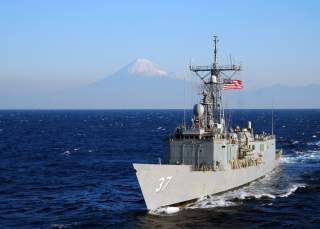The U.S. Navy Wants to Bring Back Some Old Frigates (That Can't Fight)
A fatal flaw.
The U.S. Navy is seriously considering reactivating as many as seven recently-decommissioned Oliver Hazard Perry-class guided-missile frigates in order to quickly boost the size of the U.S. Navy’s surface fleet.
But the Navy would not significantly modernize the recommissioned frigates, nor add heavy weaponry, Secretary of the Navy Richard V. Spencer said.
Rather than sending them into harm’s way in the Middle East or into the crowded, dangerous waters of the Western Pacific, the Navy would assign the 4,100-ton Perrys to the Caribbean in “a limited drug-interdiction mode,” Spencer said.
In a drug-interdiction role, the frigates could free up guided-missile destroyers and Littoral Combat Ships for more high-end missions. But Congress has been skeptical of adding lightly-armed warships to the fleet
The Navy acquired 51 Perrys between 1977 and 1989. During the Cold War, the frigates functioned as convoy escorts. With SM-1 anti-air missiles, Harpoon anti-ship missiles and two anti-submarine helicopters, the Perrys were well-rounded vessels.
Is It Time to Bring Back the Battleships?
And durable — this despite their aluminum superstructures. In 1987, USS Stark survived two hits by Iraqi Exocet missiles. USS Samuel B. Roberts struck an Iranian mine in 1988 but also survived. During a 2016 live-fire exercise, the decommissioned frigate Thach absorbed hits by four Harpoons, several Hellfire and Maverick missiles, a torpedo and two bombs. It took 12 hours for Thach to sink.
But the Navy let the frigate fleet languish in favor of Arleigh Burke-class destroyers. In 2000, the sailing branch began removing the Perrys‘ missile launchers, leaving the vessels with just their guns for self-defense.
In their later years, the frigates mostly deployed to Latin America for counterdrug patrols, although at least two vessels carried Fire Scout drone helicopters and sailed along the African coast to support Special Operations Forces. The last active ship in the class, USS Simpson, decommissioned in September 2015.
Are Submarines Almost Obsolete?
Navy officials floated the idea of recommissioning some of the Perrys around the time of Pres. Donald Trump’s inauguration in January 2017. Trump had embraced a late push by Pres. Barack Obama’s outgoing Navy secretary Ray Mabus to quickly grow the fleet from roughly 280 frontline warships to as many as 355.
Plans began to take shape for increased acquisition of Burke-class destroyers, attack submarines and multipurpose sealift ships. A proposal to reactive the aircraft carrier Kitty Hawk, which decommissioned in 2009, met with scoffs. Talk of bringing back some Perrys seemed less outlandish. The Defense Department has transferred several Perrys to foreign allies, but at least seven remain in the inactive fleet.
Spencer said it wouldn’t be expensive to reactivate the frigates. He claimed Taiwan placed two old Perrys back into service in March 2017 for a cost of just $35,000 per ship.
But that price tag didn’t include modernization. “No combat systems, but sea-ready, navigation-ready, radar-ready out the door,” Spencer said. “That’s a pretty inexpensive proven platform right there.”
Could America Beat Russia and China in a Naval War?
While foreign operators of Perry-class vessels have added modern weaponry to their vessels — most notably Australia — the U.S. Navy isn’t considering heavy armament for any frigates it recommissions. “Can you arm it up with Tomahawks?” Spencer asked rhetorically. “No.”
The downside to bringing back old Perrys is their limited utility. While perfectly adequate for intercepting drug smugglers, the frigates wouldn’t be capable of defending themselves in a major shooting war — to say nothing of performing an offensive role against a well-armed foe.
The same problem has plagued the Littoral Combat Ship, the vessel class that has begin to replace the Perrys in the Navy’s force structure. Initially entering service without a major anti-air or anti-ship missile system, the LCSs were ill-suited for frontline patrols in potential war zones.
In early 2016, U.S. senator John McCain, chair of the Senate Armed Services Committee, said the LCS was incapable of sinking an opposing force “unless the enemy fleet consists of a small number of lightly-armed boats at extremely short range.”
Under pressure from Congress, the Navy announced in 2015 it would to cut the LCS class from 52 ships to just 40 and acquire a new guided-missile frigate with significant missile armament. U.S. and foreign shipbuilders are competing to build as many as 20 of the new frigates starting in 2020.
In the meantime, the Perrys could help grow the fleet — modestly, and in a narrow role. But unless the Navy invested heavily in upgrades, recommissioning old frigates is just a short-term, partial solution to the longer-term problem of building a bigger U.S. Navy. One that can fight everywhere.
This first appeared in WarIsBoring here.

